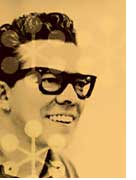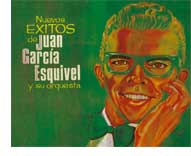Soundtrack for Modern Living: Esquivel in Orbit - Page 4
Chusid helped reawaken Hollywood and others to Esquivel's value, and the sounds of Sonorama started showing up in a variety of films, cartoons, and advertisements. But Chusid noted that Esquivel "clearly was not happy with the state he was in—a man who had been vibrant, a bon vivant, very much alive. To suddenly be rediscovered, I know he felt a personal tragedy that he couldn't capitalize on it from a personal standpoint."
Still, the refreshed influx of care and respect must have brightened Esquivel's last years. He passed away in 2002, a couple of weeks short of his 84th birthday, attended by his nurse-turned-fourth-wife Carina. His legacy was celebrated both in a 2004 documentary and in 'Homenaje' ('Homage'), a concert in Mexico City two years later. Brother Cleve carefully reconstructed Esquivel's arrangements from his recordings (the original charts had perished) and performed them in a tribute to the master at the Teatro de la Ciudad with Waitiki, a 21-piece band out of Boston.
Steve Reed flew down for the concert and sat next to Mario Esquivel, Juan's son, in the packed theater. "The feeling that went through you was, 'My god, he's alive!'" says Reed, who today remains enthusiastic about more tribute concerts, reissues, and even a statue yet to come. The vitality of Juan Garcia Esquivel will not soon be lost to a world that needs it more than ever.
Esquivel essentials
Peter Moruzzi, an architectural historian who's chaired modern architectural committees in both Los Angeles and Palm Springs, is properly fussy about the integrity of artifacts. He discovered Esquivel through Irwin Chusid and Byron Werner's 'Esquivel! Space-Age Bachelor Pad Music' CD (Bar/None), but he makes a good argument for preferring reissues of the original LP's. "It's like a poem or a novel," says Moruzzi. "Esquivel or his producer, or both, had a reason why the songs are in the order they are."

Fans and collectors differ on which originals they favor, but it should be noted that today's CD reissues in most (but not all) cases offer two original LP's together for the price of one CD. 'Infinity in Sound - Volumes 1 & 2' (Bar/None-BMG) is a good representation of Esquivel at his recording peak, in the early '60s, with his theatrical approach to arrangement animating a collection of American pop standards and a few Latin imports.
'Johnson Rag' is in itself prototypical proof of the arranger's good humor and effective juxtaposition of left and right channels, as well as of the inherent variety of an enhanced instrumental ensemble and singers performing in vocalese.
'Latin-Esque' (BMG), from 1961, as the title suggests, is an exotic showcase of Esquivel's Latin side. It includes several of Esquivel's own compositions, as well as a fascinating exercise in extreme stereo separation.

Created in that same year, but buried in RCA's vaults until its debut by House of Hits-BMG in 1999, is the delightfully evocative 'See It in Sound,' for which Esquivel and producer Neely Plumb mixed arrangements of well-known and unfamiliar tunes with the environmental sounds of familiar and exotic locales, including a bullfight and a barroom brawl.
From the period of Esquivel's integration into the contemporary lounge lifestyle, all of Chusid's compilations are fine, though there's expected repetition of material from the reissues. His 'Space-Age Bachelor Pad Music' CD is an amiable introduction to the music, graced by Chusid's informative liner notes.
To explore Esquivel further, check out the rare interview with him by V. Vale in 'Incredibly Strange Music, Vol. II' (available at www.researchpubs.com) and scroll down the list of artists at www.spaceagepop.com).
Photos: courtesy Mickey McGowan of the Unknown Museum, Michael Ochs Archives, Bar/None Records
- « first
- ‹ previous
- 1
- 2
- 3
- 4




